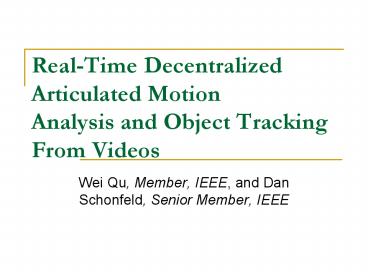Real-Time Decentralized Articulated Motion Analysis and Object Tracking From Videos - PowerPoint PPT Presentation
1 / 28
Title:
Real-Time Decentralized Articulated Motion Analysis and Object Tracking From Videos
Description:
By substituting (6) and (8) into (7), we have ... By substituting (15), (19), and (20) into (21) and approximating the integrals ... – PowerPoint PPT presentation
Number of Views:64
Avg rating:3.0/5.0
Title: Real-Time Decentralized Articulated Motion Analysis and Object Tracking From Videos
1
Real-Time Decentralized Articulated
MotionAnalysis and Object Tracking From Videos
- Wei Qu, Member, IEEE, and Dan Schonfeld, Senior
Member, IEEE
2
OUTLINE
- INTRODUCTION
- DAOT FRAMEWORK
- HAOT FRAMEWORK
- EXPERIMENTAL RESULTS
3
INTRODUCTION
- Articulated object tracking is a challenging task
such as exponentially increased computational
complexity in terms of the degrees of the object
and the frequent self-occlusions. - In this paper, we present two new articulated
motion analysis and object tracking approaches - DAOT and HAOT.
4
DECENTRALIZED FRAMEWORK FOR ARTICULATED MOTION
ANALYSIS AND OBJECT TRACKING
- A. Articulated Object RepresentationAn
articulated object can be represented by a
graphical model such as shown Fig1.
5
- In order to describe the motion of an articulated
object, we accommodate the state dynamics by a
dynamical graphical model such as shown in
Fig.2.
6
- In order to facilitate the analysis and achieve
real-time implementation, we adopt a
decentralized framework. - Fig. 3(a) shows the decomposition result for part
3 in Fig.2.
7
- B. Bayesian Conditional Density PropagationIn
this section, we formulate the motion estimation
problem. In other words, given the observations,
we want to determine the underlying object state.
Apply the Markov properties
8
- C. Sequential Monte Carlo ApproximationThe
basic idea of SMC approximation is to use a
weighted sample set to estimatethe
importance density q(?) is chosen to factorize
such that
9
- By substituting (6) and (8) into (7), we
have - models the interaction between two
neighboring parts samples and . - The local likelihood acts as a weight to the
associated interaction.
10
HIERARCHICAL DECENTRALIZED FRAMEWORK
FORARTICULATED MOTION ANALYSIS AND OBJECT
TRACKING
- A. Hierarchical Graphical Modelingwe define a
group of parts as a unit, which is denoted by ,
where is the total number of units.
11
- Similar to DAOT, we adopt a decentralized
framework and, therefore, decompose the graphical
model for each part.
12
- B. Hierarchical Bayesian Conditional Density
Propagation - Similar to DAOT, we present a Bayesian
conditional density propagation framework for
each decomposed graphical model.
13
Apply the Markov properties
14
Apply the Markov properties
15
- C. Sequential Monte Carlo Implementation
- In HAOT, the importance density q(?) is chosen to
be - The sample weights can be updated by
16
- By substituting (15), (19), and (20) into (21)
and approximating the integrals by summations, we
have
17
- in (22) can be further
approximated by a product of all parts local
observation likelihoods in unit - By first calculating all parts local observation
likelihood, we do not have to calculate the
interunit observation likelihood .
18
- D. High-Level Interaction Model
- We used a Gaussian mixture model in our
experiments to estimate the density from
training data for a walking person.
19
EXPERIMENTAL RESULTS
- The tracking performance of the proposed two
methods were compared both qualitatively and
quantitatively with the multiple independent
trackers (MIT), joint particle filter (JPF), mean
field Monte Carlo (MFMC), and loose-limbed people
tracking (LLPT), respectively.
20
Qualitative Tracking Results
- The video GIRL contains a girl moving her arms.
It has 122 frames and was captured by 25 fps with
a resolution of 320 x 240 pixels.
21
- The video 3D-FINGER has a finger bending into the
image plane. It was captured by 15 fps with a
resolution of 240 x 180 pixels and has 345
frames.
22
- The sequence WALKING contains a person walking
forward inside a classroom. It has 66 frames and
was captured by 25 fps with a resolution of 320 x
240 pixels.
23
(No Transcript)
24
- The video sequence GYM was captured in a gym from
a sideview of a person on a walking machine.
Compared with the WALKING sequence, this video is
much longer (1716 frames) and has a very
cluttered background.
25
Quantitative Performance Analysis and Comparisons
- With synthetic data
26
- In Fig. 10, we compare the RMSE of MIT, JPF and
DAOT on the synthetic video.
27
- With real datawe compare the tracking accuracy
of different approaches by defining the false
position rate (FPR) and false label rate (FLR)
28
- In Table III, we compare both the speed and
accuracy data of different particle filter-based
approaches on the WALKING sequence.

